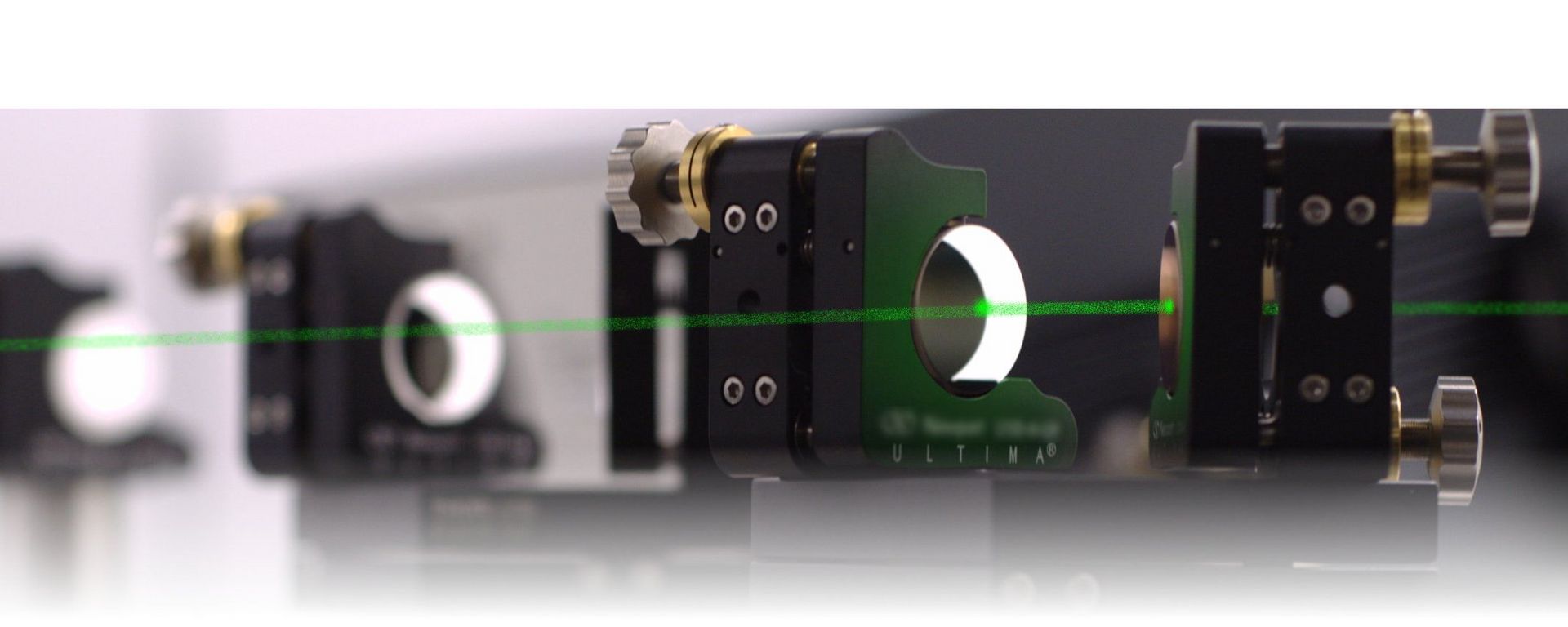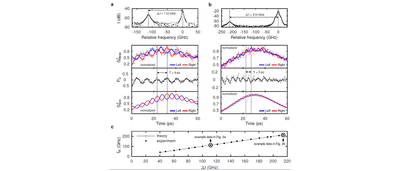Spin-optoelectronics
With further miniaturization of microprocessors and integrated circuits device number and density in such circuits increases exponentially. With extremely small dimensions a physical description of these devices has to account for quantum mechanical effects. With ongoing miniaturization parasitic effects increase their impact on device functionality, overshadowing the intended operation mode. With spintronics, the aim is to exploit quantum mechanical effects to improve and extend functionality of conventional electronic devices. To do this, the quantum mechanical spin or angular momentum of the electron is used for computation instead of its charge. As opposed to charge, spin is not a conserved quantity but rather relaxes to equilibrium where information is lost.
The field of spin-optoelectronics applies the concept of spintronics to optical devices. This enables novel effects, which can strongly enhance the performance of spin-optoelectronic devices in comparison to their conventional counterparts.
Our research is focused on efficient spin injection and detection at room temperature and in magnetic remanence on the one hand, and with spin effects in conventional lasers on the other hand. Our main focus is always to develop application-oriented devices that can operate without cryogenic cooling and strong external magnetic fields.
As part of our research on spin injection and detection we succeeded in measuring the spin relaxation length – i.e. the characteristic spin decay length – as a function both of temperature and external magnetic field.
Our results show that the 1/e decay length at room temperature and in magnetic remanence is as low as 30 nm but increases to 50 nm at 2 T magnetic field and 80 nm at 30 K. This pronounces the need to optimize spintronic devices under application settings as those differ significantly from usual laboratory settings [1-3,13].
But most relevant for applications such as optical data communications is the laser. For short-haul data transmission systems, e.g. within data centers, typically vertical-cavity surface-emitting semiconductor lasers (VCSELs) are used. In particular, VCSELs are suitable devices for spin-lasers, because the vertical geometry is advantageous for the conversion of the carrier spin into the polarization of the emission. To transmit data, instead of the intensity the polarization is modulated in spin-VCSELs. We could show that the resonance frequency of the polarization dynamics is decoupled from the resonance frequency of the intensity dynamics [4,5,9,11,13,16]. Thus, alternative strategies to enhance the modulation bandwidth can be used. For example, this is possible by introducing strain into the device: Via the elasto-optic effect the birefringence in the laser cavity can be influenced. The birefringence is the main property of the spin-VCSEL to control the modulation bandwidth [9]. In order to obtain high birefringence, several strategies were investigated. The birefringence could be increased from its typical value of some GHz up to extreme values of more than 250 GHz utilizing a mechanical bending approach [8]. Furthermore, also integrated methods were developed, which enable birefringence control via an additional electrical current [10] or by a custom designed surface grating, which can be implemented during the process of manufacturing [12].
We demonstrated experimentally, that the polarization dynamics in a spin-VCSEL with high birefringence can reach dynamics of at least 212 GHz [11]. This is 27 times faster than the intensity dynamics in the same laser. Additionally, two further benefits arise when polarization dynamics in spin-VCSELs are used: Conventional, intensity modulated lasers are typically driven at maximum bias current in order to enable them to reach their highest possible modulation bandwidth. This results in high energy consumption and waste heat generation. In contrast, the maximum modulation bandwidth of the spin-VCSEL is decoupled from the bias current of the laser. Thus it is possible to reach the maximum modulation bandwidth already closely above threshold current, resulting in lower energy consumption [11].
Another advantage of the polarization dynamics is their independence from temperature [16]. This can save additional cooling effort when spin-VCSELs are used in an application context such as optical data transmission. The ultrafast spin-VCSEL was not only investigated experimentally, but also a very good agreement between experimental results and simulations utilizing the spin-flip model proposed by San Miguel et al. were obtained, especially by generalizing it towards a parameter range with extremely high birefringence values [11,17]. This enables extensive theoretical investigation by calculating the behavior of the laser without experiments. Not only resonance oscillations could be reproduced by the model [4-6, 9, 11], but also continuous modulation [11] and even switching of resonance oscillations after an arbitrary number of oscillation periods [7].
The injection of the carrier spin polarization into the spin-VCSEL was performed optically in all our previous experiments. This requires additional lasers and optical setups to generate and modulate the circular polarization of the injected light, thus losing the advantage of a compact and integrated device.
Figure 3: Ultrafast polarization dynamics in a spin-VCSEL for mode splittings of 112 GHz (a) and 212 GHz (b). The optical spectra I show the measured mode splitting. S±Meas are the measured traces of the circular intensities, which are used to calculate the circuar polarization degree PC. PC shows an oscillation with the frequency given by the mode splitting. S±Sim are traces calculated using the generalized spin-flip model with very good agreement with the experimental data. The frequency f~R of the oscillation in PC‘, which is the resonance frequency oft he polarization dynamics, can be tuned using the mode spitting (c). From [11]: M. Lindemann, G. Xu, T. Pusch, R. Michalzik, M. R. Hofmann, I. Žutić and N. C. Gerhardt, Ultrafast spin-lasers, Nature 568, 212 (2019).
Therefore, for the application in a data center the optical spin injection needs to be replaced by electrical spin-injection, which is, however, challenging due to the aspects which have been mentioned above in the context of the spin-LED: A spin-VCSEL has not yet been demonstrated at room temperature, as the injection path length between injection contacts and quantum wells in the laser cavity is too long for the spin-polarized carriers to pass within the spin-lifetime at room temperature. The spin-lifetime can be extended by cooling the device, hence spin-VCSELs could so far only be demonstrated at temperatures up to 230 K by Basu et al., requiring cryogenic cooling. As a solution we have proposed a device architecture that offers much shorter injection path lengths, which should enable room temperature operation [14,15]. This concept comprises a highly reflective surface grating replacing the upper Bragg mirror, which also contains spin-injection contacts within its grooves. With the development of room temperature devices, the spin-VCSEL poses a promising alternative to the conventional data transmission technology, promising an order of magnitude higher bandwidth and an order of magnitude lower energy consumption.
Reference:
- [1] Henning Soldat, Mingyuan Li, Arne Ludwig, Astrid Ludwig, Frank Stromberg, Heiko Wende, Werner Keune, Dirk Reuter, Andreas D. Wieck, Nils C. Gerhardt, Martin R. Hofmann, Magnetic field dependence of the spin relaxation length in spin light-emitting diodes, Applied Physics Letters 99 (5), 051102 (2011)
- [2] Henning Höpfner, Carola Fritsche, Arne Ludwig, Astrid Ludwig, Frank Stromberg, Heiko Wende, Werner Keune, Dirk Reuter, Andreas D. Wieck, Nils C. Gerhardt, Martin R. Hofmann, Magnetic field dependence of the spin relaxation length in spin light-emitting diodes, Applied Physics Letters 101 (11), 112402 (2012)
- [3] A. Ludwig, B. Sothmann, Henning Höpfner, Nils C. Gerhardt, J. Nannen, T. Kümmell, J. König, Martin R. Hofmann, G. Bacher, A.D. Wieck, Quantum dot spintronics: fundamentals and applications, in H. Zabel and M. Farle (eds.), Magnetic Nanostructures, Springer Tracts in Modern Physics 246, 235 (2013)
- [4] Mingyuan Li, Hendrik Jähme, Henning Soldat, Nils C. Gerhardt, Martin R. Hofmann, Thorsten Ackemann, Birefringence controlled room-temperature picosecond spin dynamics close to the threshold of vertical-cavity surface-emitting laser devices, Applied Physics Letters 97 (19), 191114 (2010)
- [5] Nils C. Gerhardt, Mingyuan Li, Hendrik Jähme, Henning Höpfner, Thorsten Ackemann, Martin R. Hofmann, Ultrafast spin-induced polarization oscillations with tunable lifetime in vertical-cavity surface-emitting lasers, Applied Physics Letters 99 (15), 151107 (2011)
- [6] Nils C. Gerhardt and Martin R. Hofmann, Spin-Controlled Vertical-Cavity Surface-Emitting Lasers, Advances in Optical Technologies 2012, 268949 (2012)
- [7] Henning Höpfner, Markus Lindemann, Nils C. Gerhardt, and Martin R. Hofmann, Controlled switching of ultrafast circular polarization oscillations in spin-polarized vertical-cavity surface-emitting lasers, Applied Physics Letters 104, 022409 (2014)
- [8] Tobias Pusch, Markus Lindemann, Nils C. Gerhardt, Martin R. Hofmann and Rainer Michalzik, Vertical-cavity surface-emitting lasers with birefringence splitting above 250 GHz, Electronics Letters 51, 1600 (2015)
- [9] Markus Lindemann, Tobias Pusch, Rainer Michalzik, Nils C. Gerhardt, and Martin R. Hofmann, Frequency tuning of polarization oscillations: Toward high-speed spin-lasers, Applied Physics Letters 108, 042404 (2016)
- [10] Tobias Pusch, Eros La Tona, Markus Lindemann, Nils C. Gerhardt, Martin R. Hofmann, and Rainer Michalzik, Monolithic vertical-cavity surface-emitting laser with thermally tunable birefringence, Applied Physics Letters 110, 151106 (2017)
- [11] Markus Lindemann, Gaofeng Xu, Tobias Pusch, Rainer Michalzik, Martin R. Hofmann, Igor Žutić and Nils C. Gerhardt, Ultrafast spin-lasers, Nature 568, 212 (2019)
- [12] Tobias Pusch, Pierluigi Debernardi, Markus Lindemann, Friederike Erb, Nils C. Gerhardt, Martin R. Hofmann and Rainer Michalzik, Vertical-cavity surface-emitting laser with integrated surface grating for high birefringence splitting, Electronics Letters 55, 1055 (2019)
- [13] Igor Zutic, Jeongsu Lee, Christian Gothgen, Paolo E. Faria Junior, Gaofeng Xu, Guilgheme M. Sipahi, Nils C. Gerhardt, “Chapter 16 – Semiconductor Spin-Lasers”, Spintronic Handbook: Spin Transport and Magnetism, Volume 3: Nanoscale Spintronics and Applications, 2. Ed., edited by E.Y. Tsymbal and I. Zutic, (2019)
- [14] Patent: Markus Lindemann, Martin R. Hofmann, Nils C. Gerhardt, WO002019170517A1 (2019)
- [15] Markus Lindemann, Ultraschnelle Spin-Laser (Springer), 2020
- [16] Markus Lindemann, Natalie Jung, Pascal Stadler, Tobias Pusch, Rainer Michalzik, Martin R. Hofmann, and Nils C. Gerhardt, Bias current and temperature dependence of polarization dynamics in spin-lasers with electrically tunable birefringence, AIP Advances 10, 035211 (2020)
- [17] Igor Žutić, Gaofeng Xu, Markus Lindemann, Paulo E. Faria Junior, Jeongsu Lee, Velimir Labinac, Kristian Stojšić, Guilherme M. Sipahi, Martin R. Hofmann, Nils C. Gerhardt, Spin-lasers: spintronics beyond magnetoresistance, Solid State Communications 316, 113949 (2020)
Colleagues:



